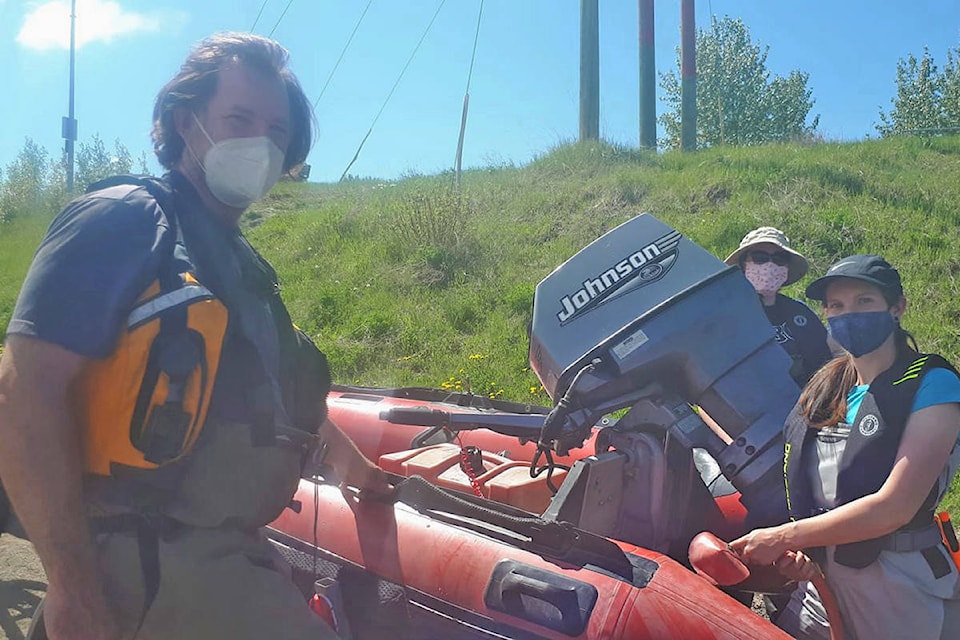It’s spawning season for B.C. white sturgeon in the Nechako River and researcher Steve McAdam has been keeping busy.
The hydroelectric impact and sturgeon specialist with the Ministry of Environment and Climate Change Strategy is conducting a few experiments this year focused on the egg stage and how the eggs interact with different habitat types.
“One of the things we’re quite interested in is the substrate condition in the Nechako River,” McAdam said, noting a lot his work is focused on the mechanism that appears to have caused recruitment failure. Evidence of substrate changes has also been observed in the Columbia and Kootenay Rivers.
Flows in the Nechako River have been regulated since the completion of the Kenny Dam in 1952 according to the Ministry of Forests, Lands and Natural Resource Operations.
McAdam has been working with the Nechako White Sturgeon Recovery Initiative since 2001 and is primarily interested in the stage after the eggs, which is the yolk-sac larvae and how they need to hide in the substrate’s interstitial spaces.
Sturgeon eggs become adhesive once laid by a female where they stick to the bottom of their habitat.
Once the larvae hatch about nine days later, they hide to protect themselves from predators such as otters.
Read More: Juvenile Nechako white sturgeon to be released in June
“If you have a bunch of gravel, you have spaces between the gravel and those are called interstitial spaces, and the larvae will hide in them. If they can’t hide in them, we’ve shown that they will drift downstream, and they’re more prone to predators,” he said.
“We’ve seen both the biological effect of the absence of interstitial habitat and we have evidence of in-filling— an increase in sand substrate in the Nechako River at about the time the recruitment failure started, which is 1967. We’re trying to get some ideas of how these various substrates (gravel, sand or a larger cobble substrate) affect the egg stage.”
Those ideas McAdam said will help experts design future habitat restoration measures.
Another study the Ministry of Environment and Climate Change Strategy is working on is releasing eggs in a substrate mixture of cobble and gravel called the middle pad, where habitat restoration took place in 2011. While it is believed wild adults have not spawned in this location for the past few years, it is a location where researchers can deposit eggs in which it is hoped the yolk sac larvae will survive and produce juvenile sturgeon that can be detected years down the road, McAdam said.
Research on substrates in the Nechako River began as early as 2003 with experiments on how yolk-sac larvae reacted to substrate occurring two years later. One day old larvae were released in 2008 onto fresh gravel that was helicoptered in, and in 2011 gravel substrate additions were added near the Burrard Avenue Bridge (lower pad) and near Stoney Creek (upper pad).
Experimental mechanical cleaning of the lower pad near Burrard Avenue Bridge was conducted in 2016 to send sand downstream and leave larger particles in place while improving the habitat.
The same technique was undertaken with divers in 2020.
Read More: Want to name the largest sturgeon ever caught by the hatchery in Vanderhoof? Here is your chance
“We keep learning,” McAdam said.
The lower pad filled with sand within a year was a surprise to Adam and others who said it had filled in quicker than they expected.
“That led to a lot of studies of how the substrate moves in the river and understanding how sand moves in the river has become an important focus in terms of designs going forward on habitat restoration,” McAdam added.
The Carrier Sekani Tribal Council typically undertakes spawn monitoring each year in which wild eggs are collected through a frame-like structure with a filter mesh and taken back to the hatchery.
Two groups of fish are reared at the Nechako White Sturgeon Conservation Centre, including broodstock, where spawning is induced and sturgeon are reared up to two years of age before they are released, and wild-caught naturally spawned eggs.
The development of a five-year substrate restoration plan is anticipated to be completed by the fall.
“We’re just now receiving some funding now front the Nechako Environmental Enhancement Fund and the plan is to implement some substrate restoration in 2022,” McAdam said.
“I don’t think we’ll be as large a scale as were in 2011 but our plan is to keep chipping away at it year by year, so I hope we could add some more substrate in some manner and learn more about it in 2022.”
This year’s winter habitat use of juvenile sturgeon is also anticipated to be evaluated by the Carrier Sekani Tribal Council.
He said there remain many unknowns about the charismatic, large fish that have been around for millions of years.
“There’s a lot of uncertainty on the sturgeon side, and then obviously regulated rivers and generating electricity from rivers is something that society gains benefit from, so I guess one of our big challenges is how do we balance those two and we’re still learning how to do that.”
Do you have a comment about this story? email:
rebecca.dyok@wltribune.com
Like us on Facebook and follow us on Twitter.
